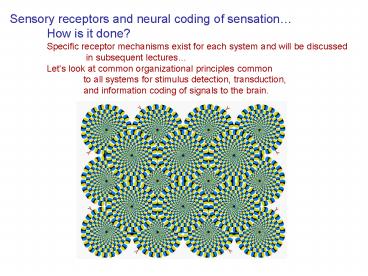Sensory receptors and neural coding of sensation - PowerPoint PPT Presentation
1 / 22
Title: Sensory receptors and neural coding of sensation
1
Sensory receptors and neural coding of
sensation How is it done? Specific receptor
mechanisms exist for each system and will be
discussed in subsequent lectures Lets look
at common organizational principles common to
all systems for stimulus detection,
transduction, and information coding of signals
to the brain.
2
Psychophysics demonstrated that perception and
behavior could be described and studied
empirically 1) Studies relationship between
physical stimulus and the attributes of sensory
experience 2) Early psychophysicists such as
Ernst Weber and Gustav Fechner believed that
they could explain the minds perception by
describing the sensory stimulus experience.
They did not succeed, but were conceptually
correct
Gustav Fechner
Ernst Weber
3
Sensory function basics 1) In the 19th
century, Weber and Fechner used psychophysics to
discover that all sensory systems encode four
attributes of a stimulus. a) modality vision,
touch, audition, taste, smell vestibular
(motion) b) intensity level of
stimulation c) duration temporal
sequence d) location spatial topography
2) When combined, these four attributes give rise
to sensation.
4
What is sensory threshold (So) and how is it
determined? Psychometric functions
Threshold lowers (attention)
Threshold increases (tolerance dysfunction)
0.75
Detection threshold
0.25
Stimulus magnitude
Method of constant stimuli (yes/no response)
JND r(.75) r(.25)/2
Two alternative-forced choice task
5
Detection threshold used for audiometrics
Method of constant stimuli
Normal hearing
High frequency loss (left) Moderate broadband
loss (right)
6
Psychophysics established a relationship between
intensity of sensation and stimulus magnitude
1) Intensity of sensation depends upon strength
of stimulus Webers law S K x S where
S minimal difference in strength between a
reference stimulus S and a second stimulus
that can be discriminated, K scaling
constant This is known as the just noticeable
difference (jnd) 2) Later, it was found that
the intensity of sensation is best described by a
power function. Fechner/Stevens law I K(S
So)n where I intensity of sensation, S
stimulus strength, and So threshold
amplitude of the stimulus
This is useful, since sensory systems must
respond to stimuli that vary over several orders
of magnitude in Strength (non-linear)
7
Sensory physiology 1) Studies relationship
between physical stimulus and neural
response 2) Quantifies stimulation parameters,
transduction, neural coding,
and information processing in the CNS
Today Merging of psychophysics with sensory
physiology has produced new understandings into
how neural systems give rise to perception,
decision making, and behavior. Why are the two
not in perfect correspondence?
Because, previous experience and learned (or
acquired) biases (priors) weight
perception and decisions.
8
Receptors are modality specific 1) Johannes
Muller (1826) formulated the Doctrine
of Specific Nerve Energies. States that each
receptor and its innervating nerve gives rise
to only one type of sensation. 2) Receptors
when stimulated with any type of stimulus
(electric shock) always signal specific
modality. Useful for prosthetics like cochlear
implants .
9
XX
Linear and rotational acceleration
10
Spatial and temporal summation of receptor
potentials in Pacinian corpuscle Note
linear summation of receptor potential
Spatial summation A and B applied at same
location C applied at different location
Temporal summation A and C applied at different
relative times
11
Action potentials are the elementary units of the
neural code
Binary code 1 bit (on/off)
12
Sensory systems encode 4 basic attributes of
stimuli produce sensation
Small probe to center of receptive field
slow adaptation
rapid adaptation
13
Neural adaptation important principle of neural
coding
All sensory receptors and nerve fibers adapt to
constant stimulation. Adaptation varies
from slow to rapid. Slow sustained
stimuli Rapid on/off, time derivative
of stimulation (velocity,
acceleration of stimulus)
Examples of adaptation in touch nerve fibers
14
Receptive fields vary across the surface
Two-point discrimination
Receptive fields
Mean threshold (mm)
15
Spatial resolution determined by density of
receptors and receptive field size
In the human retina, there are 120 million
rods and 7 million cones
16
Neural mechanisms underlying psychophysics
Neural firing rate, duration, and number of cells
in synchrony together encode intensity and
temporal resolution of sensation
Response of somato-mechanoreceptor fiber
Subjects verbal report of stimulus magnitude
Neural firing frequency (spikes/sec)
Threshold 80mm
The correlations between sensation and neural
firing rate suggest that the psychometric and
neurometric functions are in register
I K(S So)n
n 1
17
Receptors and neurons are tuned with different
bandwidths
Cochlear hair cells
VIIIth nerve fibers (auditory branch)
Chorda tympani fibers (VII)
18
Spatial distribution of receptors topographic
code
Salamander olfactory bulb
Topographic activity codes for hedonics
limonene
Optical imaging with voltage sensitive
dyes. Hotter colors indicate more neural
activity.
Receptive field determines location Each receptor
only responds to stimuli in its receptive
field
ethyl-n-butyrate
19
Neurons have noise
Neural noise gives rise to uncertainty. Must use
population of cells to better discriminate.
50 trials of visual stimulus while recording
from fly visual neuron H1
PSTH represents probability r(t) per unit
time that neuron will fire
20
Neural sensitivity and noise level affects signal
code
Irregular firing neurons have greater noise
Low sensitivity
Noise
Signal
High sensitivity
Noise
Signal
Regular firing neurons have less noise
21
Ascending neural coding complex interactions
Convergence produces large receptive fields
and loss of specificity
Inhibitory interneurons increase contrast
and sharpen signal/noise
22
Neural population coding
Superior colliculus topographic map codes for
eye movement to visual target of interest in
retinal space reference frame
Feature encoding by population of neurons.
Overlapping orientation tunings give rise to
sharpened vector population response. Better
than any single neuron.































